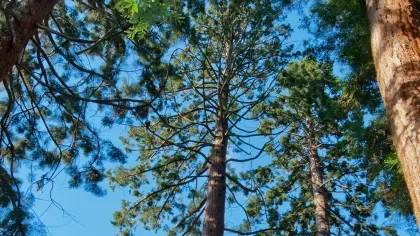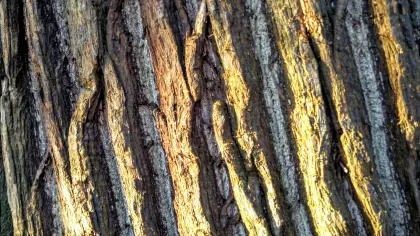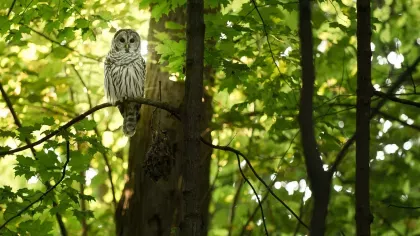8 June 2018
Kew’s unwanted guests: Tackling Oak Processionary Moths
You might have noticed that parts of the Gardens are sometimes closed off. Kew is hard at work tackling the spread of Oak Processionary Moths. Head of The Arboretum Tony Kirkham explains what are they, and why they are a problem.

What are Oak Processionary Moths (OPM)?
OPM come from the Mediterranean, where their numbers are kept in check by predators.
These predators don’t exist in Northern Europe, and populations of the moth have sprung up as far north as Sweden.
The moths were first spotted in London in 2006, and if left unchecked they’re likely to spread across the country.
The caterpillars of OPM live and feed on oak trees, and in early summer they build white nests on the trunks and branches. The nests are built in a variety of weird and wonderful shapes, sometimes like a blanket stretched around part of a trunk.
It sounds innocuous, but those little insects can do a world of damage.
Tree health threats
OPM caterpillars can threaten the health of oak trees, because they can strip the branches bare of leaves, leaving them vulnerable to attack by other pests and diseases.
It’s not just the trees that are at risk.
We have to control the caterpillars to protect human health.
Each caterpillar has 62,000 tiny toxic hairs which can be released. When the hairs come into contact with human skin or animal fur, they can cause severe dermatitis, asthma or more seriously anaphylactic shock.
The hairs can cover oak trees and be dispersed by the wind, so you don’t even need to be close to an oak tree to be affected.
We have a duty of care for our staff, contractors and visitors to keep the gardens safe – it’s very important that we manage them before they become a threat to health.

Our action plan
We keep a close eye on our oak trees for signs of feeding damage.
The leaves start to look like skeletons when they are eaten by the caterpillars, so that’s one way of spotting them.
You can also see them moving around on branches and trunks in nose-to-tail processions (which is how they got their name).
Each year in the late Spring, we close parts of the garden to tackle the OPMs just for a couple of days. During the life cycle of this moth the caterpillar sheds its skin 6 times before pupation. Each moult is called an instar.
We spray an insecticide growth regulator on the trees which stops the caterpillars developing into the next caterpillar stage or instar.
We apply this once a year, usually the first or second Monday in May, which I’ve estimated is the best time for the treatment to be effective and before the hairs become harmful to people and animals.
We use four commercial spraying rigs, and a tree expert company assisted by our own arborists who are familiar with our trees at Kew.
The trees are identified and marked up with hazard tape the week before spraying, which speeds up the operation and reduces collateral damage to neighbouring trees.
We know it can be disappointing when sections of the gardens are closed.
But we hope everyone understands the importance of preventing the spread of these pests at Kew, so that we can provide a safe environment for our visitors, as well as for our trees.


